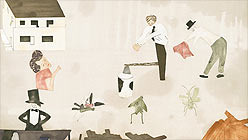Printmaking is a mysterious art form. Its techniques include sassy-sounding phrases like spit bite, aqua tint, and sugar lift. To an untrained viewer, these terms are meaningless but no less intriguing. Before perusing the latest edition of Crown Point Press‘s Magical Secrets series of books on printmaking, I stopped by their gallery to check out the latest group exhibition, Invention/Tradition to see if I could detect whether or not “spit bite” actually involves spitting and biting. It doesn’t.
To know me is to know that I’m drawn to color. With this disclaimer out of the way, I can tell you about my favorite prints in the show created by artists Laura Owens and Jockum Nordström. In Nordström’s print titled House and Bugs, awkwardly charming, folksy characters meander between skewed simplistic architecture and piles of wood. The print looks like a disturbed child’s watercolor rendering of Abe Lincoln’s days in office. Though at first glance it seems child-like, Nordström’s work has subtly dark and erotic edges. A print called Back to the Land features two women and a sailor-suited man near a fruit tree with an oddly shaped gloomy cloud looming overhead, and the artist’s sauciest print was suggestively titled, Lick My Hand.
A colorful image of a chicken by Laura Owens graces the cover of the Magical Secrets about Thinking Creatively by Crown Point Press founder and director, Kathan Brown, but it is in the newest Magical Secrets book where you can read about Owens’s process for creating one of her pieces in the new exhibition, a whimsical blue horse with a flowery vine for a tail. After seeing the piece in person, I cracked open Magical Secrets about Aquatint by master printer Emily York to learn how it was made; what chemicals were used, how Owens’s brushstrokes appeared on the horse but not on the background, and how each layer affected the final, printed image. York also worked with Nordström on his prints in the show, and her book includes detailed accounts of her experience working with other artists who have spent time at Crown Point Press. Reading about these renowned artists’ processes through the eyes of the expert printer who worked alongside them is, indeed, like discovering a magical secret.
There is a liberty in printmaking that other art forms lack — it is meant for more than one person, and it takes more than one person to create a fine art print. At Crown Point Press, prints are run in limited editions, and many of the images are eventually published as beautiful books for sale in the cozy bookstore next to the gallery. The store also sells decks of playing cards with Nordström’s designs, that’s 52 little pieces of art. Want to make your own prints? The bookstore has supplies and instructional books, or you can purchase a kit with a copper plate and materials to create your own etching to be sent back to Crown Point for printing.
True appreciation of fine art printmaking is cerebral. You can contemplate the image that the artist has carefully selected to be repeated, and you can also examine each layer and mark, considering the steps that have been taken to preserve the presence of the artist’s hand in the original gesture as it is transferred to the final print. In short, a mark may look like it was made by a pencil, but it wasn’t. And what might look like watercolor paint is actually color spit bite and sugar lift aquatint. There is a complicated alchemical and often magical process that happens during the transfer, and the results can be, in York’s words about a Kiki Smith print, “Stunning.”


